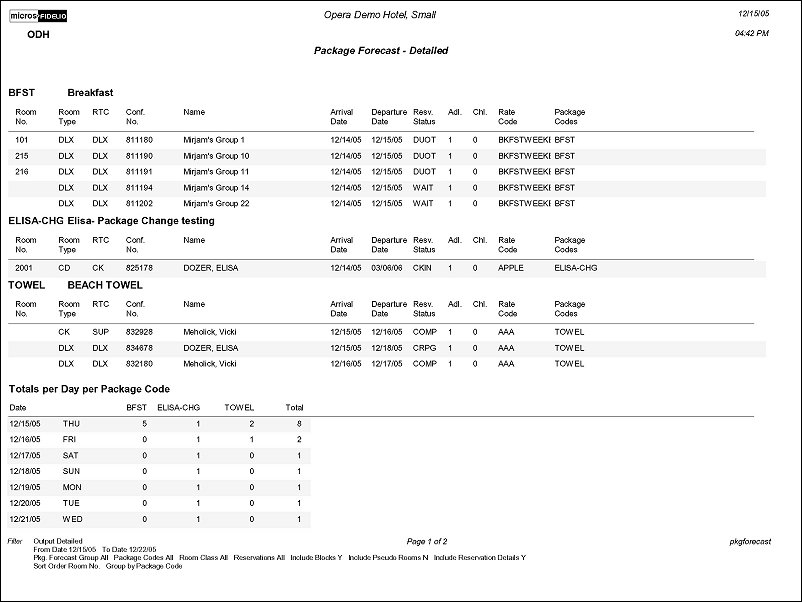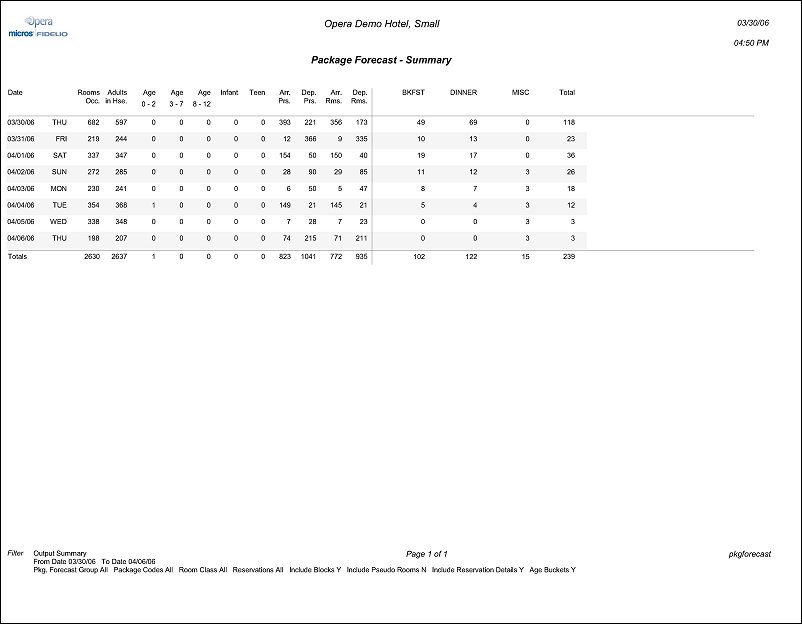
Package Forecast (pkgforecast with FOR6.FMX)
The Package Forecast report will display a daily breakdown of the number of reservations, or anticipated reservations, with an attached package. If the reservation has multiple rooms attached, the report will calculate the number of packages by multiplying the number of persons times the number of rooms. The package can be either on a rate code, Block Header or directly on a reservation. This also includes blocks not picked up when a package is attached for a specific date of the block. This report contains the ability to display either a detailed breakdown per package code or a summarized breakdown by the Package Forecast Group.
The summary report may include a breakdown by child age buckets at properties where age buckets are configured.
Package Forecast Groups may be configured via the menu option located under Rate Management>Codes>Package Forecast Groups. These may then be attached to each package. The “grouping” of like Package codes into like groups allows for a quick forecasting tool. Examples of Package Forecast Groups would be Breakfast, Lunch, Dinner, Amenities, Sports, etc.
If a Group Package is attached to a reservation, the report output will include the Packages that make up that group only. The Group Package will not be displayed anywhere on the report output.
An additional element of the reports functionality is the ability of OPERA to understand when a Package is scheduled for consumption. An example of this would be a Breakfast package configured to “Post Next Day” – thus consumption would not occur on the guest’s arrival date. The Package forecast report would not display a Breakfast forecast for day of arrival but rather for the following days of the guest stay. Even if a Package element is not selected for Post Next Day, it can still be configured as "Forecast Next Day" and will be displayed on the report.
Example: B&B Rate code is configured with a Breakfast and a Bathrobe package attached. Both packages are configured as Per Person. The Breakfast package has been marked to “Post Next Day.”
John Smith has an Arrival date of January 5 and will be staying for 3 nights, 2 guests will be in the room. He has booked the B&B rate code. The package forecast breakdown would display as follows:
In addition, the report will consider the posting rhythms configured on the package when determining the forecast.
Other considerations:
Summary. Output will display forecasted consumption by Package Forecast Group. The figure displayed will represent the number of Persons, not reservations. This means the report will look at the Quantity of Packages designated on the Reservation, as well as, the configuration of the Package. This will be important in packages that are configured based on the number of Persons.
Detail. Output will display forecasted consumption by Package Code. The figure displayed will represent the number of Persons, not reservations. This means the report will look at the Quantity of Packages designated on the Reservation, as well as, the configuration of the Package. This will be important in packages that are configured based on the number of Persons.
From Date. Default will be the current Business date. The Begin date can be any date equal to or greater than the current Business Date.
To Date. Default will be current Business Date + 7 days. The End date can be any date greater than or equal to the Begin Date.
Package Forecast Group. Type a comma separated list or use the multi select LOV for filtering on specific Package Forecast Groups. Only include Reservations that have Package Code(s) that are attached to the selected Package Forecast Group, on a Reservation/Block.
Package Code. Type a comma separated list or use the multi select LOV for filtering on specific Package Codes. Only include Reservations that have the selected Package Code(s) attached to a Reservation/Block.
Room Class. Type a comma separated list or use the multi select LOV for filtering on specific Room Classes. Only include Reservations/Blocks that are made for a Room Type that is in the selected Room Class. The Room Class filter is only displayed when the General>Room Class application function is set to Y.
Deduct. Default will be with the Checkbox selected. When selected, the report output will include all Room Reservations that have a Reservation type attached that has been marked as “Deduct” from Inventory.
Non Deduct. Default will be with checkbox NOT selected. When selected, the report output will include all Room Reservations that have a Reservation type attached that has NOT been marked as “Deduct” from Inventory. This will not include Cancelled or No Show Reservations.
Block Rooms Not Picked Up. Default will be with the check box not selected. When selected, the Package Forecast report will take into consideration the rooms reserved on a Block that do not yet have Reservations booked against them. This means Blocks that are “Open for Pickup” only. This will take into account a Package attached to either the Rate Code on the Block Header or a Package directly attached to the Block Header. For reporting purposes it will always be assumed a Block room that has not yet been picked up, is single occupancy.
When the Summary check box is selected, the Arrival Persons and Departure Persons columns appear on the report. Arrival Persons and Departure Persons for Block Rooms Not Picked Up are calculated as follows:
For each day of the block, OPERA notes the difference between rooms remaining for the previous day and the day of interest. If the number of rooms remaining for the day of interest is higher than the previous day, this means that arrival rooms are needed to fill the remaining rooms. If the number of rooms remaining for the day of interest is lower than the previous day, this means that departure rooms are needed. For example, assume a block for 5 days. All rooms are single occupancy.
|
Rooms Remaining |
Arrivals |
Departures |
Day 1 |
10 |
10 |
|
Day 2 |
12 |
2 |
|
Day 3 |
8 |
|
4 |
Day 4 |
5 |
|
3 |
Day 5 |
9 |
4 |
|
Day 6 |
no rooms |
|
9 |
Pseudo Rooms. Include Reservations made for a Room type configured as a Pseudo Room.
Reservation Details. When the Detail option button has been selected, the check box will default to checked. When selected, the report output will display each individual Reservation that makes up the Package forecasted numbers, and additional reservation information pertaining to that guest. Block Rooms that have not been picked up, will not be included in the reservation breakdown. If the check box is not selected, the Detailed report output will not include a breakdown of Reservations.
Age Buckets. When the Summary option button is selected, the Age Buckets check box becomes available, provided that the Rates>Rates Defined by Buckets application function is set to Y. (When Age Buckets is selected, the Reservation Details check box becomes unavailable.) The report output will show a breakdown of children in house by the age buckets configured using the Rates>Min Age Rate Bucket1, -2, -3 application settings along with the Rates>Max Age Rate Bucket1, -2, -3 application settings, and the Rates>Rate Bucket4 and -5 application settings.
Note: If the report is output with the Summary option button selected and the Age Buckets check box is not selected, it will show a total of Children in House instead of the breakdown of children by age buckets.
Sort Order. Room No., Guest Name.
Group By. Package Code, None

